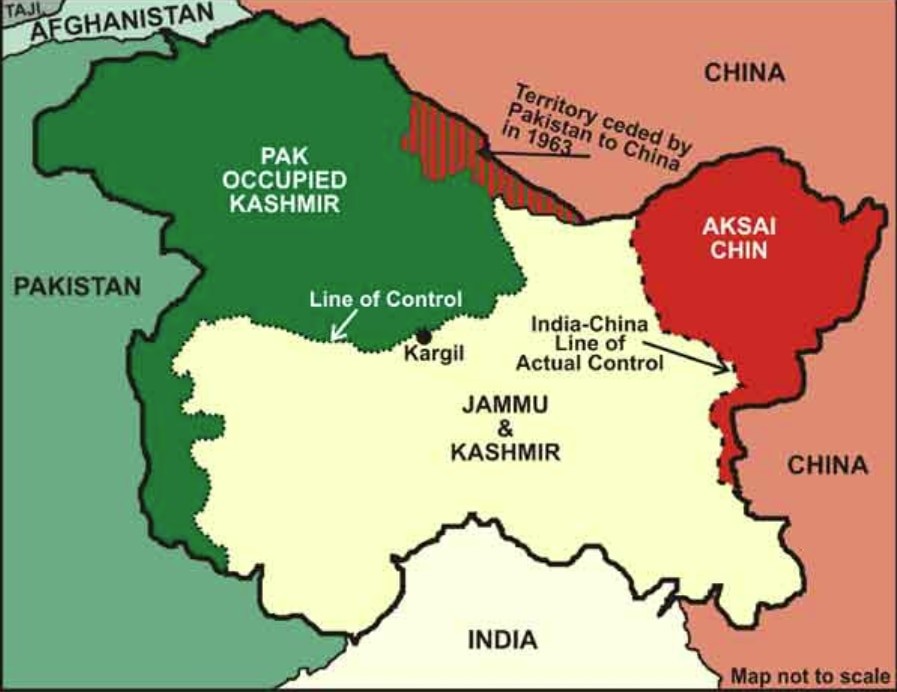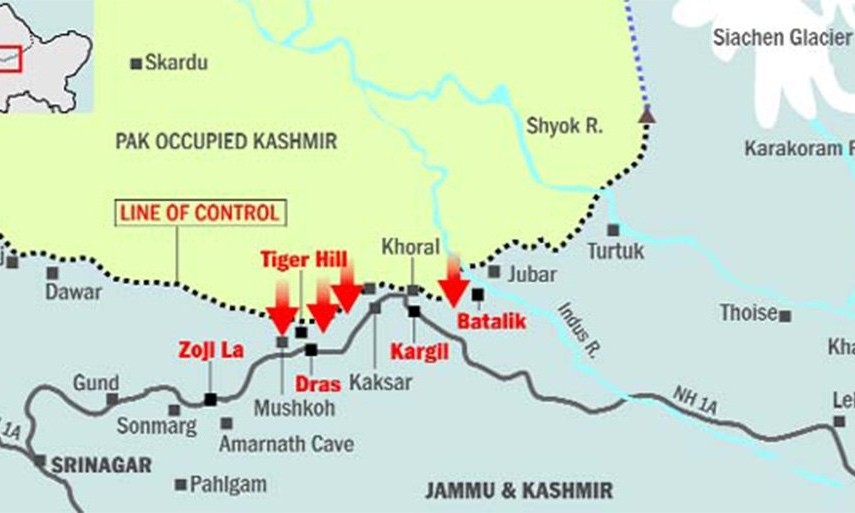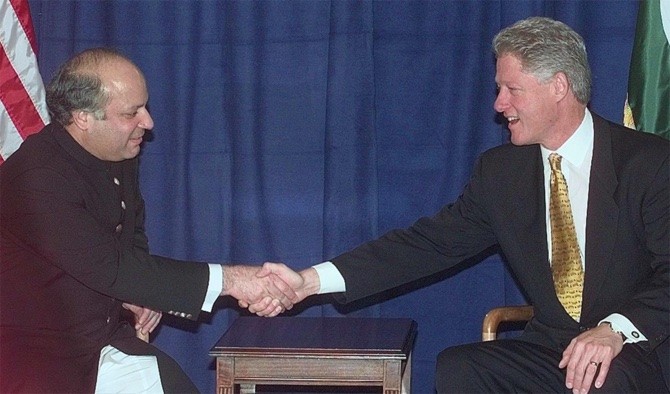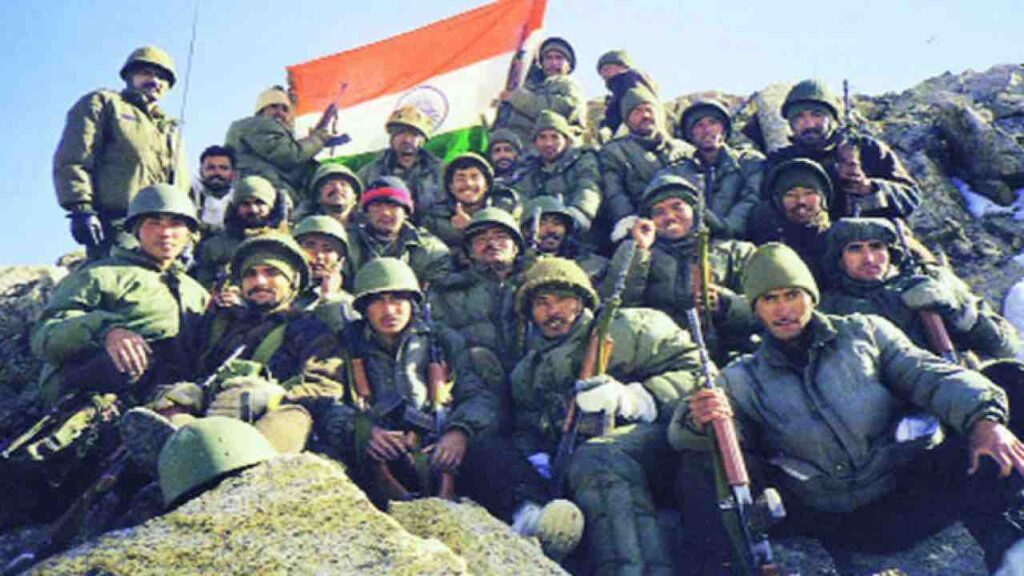Table of Contents
The war of 1999 between India and Pakistan, also known as the Kargil War, was the last conventional war fought between the two nations. Before Kargil War, the two nuclear states fought three battles –
- The India Pakistan war of 1947/48, where the Pashtun tribesmen and militias from Pakistan attacked the independent state of Jammu & Kashmir (J&K). The state of Jammu & Kashmir later acceded to India during the war. By the end of the war, India was able to keep major parts of J&K under its control.
- The India Pakistan war of 1965, where Pakistan planned to initiate the revolt against India using the local populace of Kashmir and capture parts of Indian-administered Kashmir. At the end of the war, Pakistan and India gave up their captured territories as per Tashkent Agreement.
- Bangladesh Liberation War of 1971, where India and Pakistan fought in East Bengal. The war ended with India being victorious and a new state, Bangladesh, being born.
In all of the battles including the Kargil War, India came out to be victorious. The Kashmir issue has been a hot topic of discussion for both countries and has been the primary reason for confrontation between the two states. Pakistan has always maintained that Kashmir is a Muslim-dominated region and should accede to Pakistan. India on the other hand has maintained that Jammu & Kashmir acceded to India in 1947 and thus is an integral part of the country.
Introduction
The Kargil War took place in the Kargil region of Kashmir on the Indian side of LoC (Line of Control). The war covered Kargil and stretched to some of the other areas along the LoC. Pakistan chose Kargil for infiltration and attack because of its location with respect to National Highway 1. NH 1 is the road connecting Srinagar to Leh, and Kargil cuts through that route. Pakistan knew that taking control of NH 1 would isolate Kashmir from Leh and Ladakh, and would also isolate the Siachen Glacier that it had been eying to take control of for a long time.

Courtesy – India Today
Also, Kargil is strategically located (with dense peaks). This helped Pakistan to take safe positions away from the eyes of the Indian army. Thus, when Pakistan infiltrated, they created bunkers on the peaks and took a defensive position to watch and attack any offensive from the Indian side.
The Kargil War was fought between May-July 1999.
Operations and Codenames
Apart from Kargil, the infiltrators also captured the Mushko Valley, Drass, Batalik sector, and some areas southwest and northeast of Kargil.
To clear out the Pakistani infiltrators from Kargil and other areas along the LoC, India gave a codename to the military operation i.e. Operation Vijay (Vijay in Hindi – Victory in English). The Indian Air Force also took part in the war helping the Indian Army to flush out the Pakistani infiltrators along the Indian side of LoC. Operation Safed Sagar (Safed Sagar in Hindi – the White Sea in English) became the codename of Indian Air Force offensive against Pakistan.
Initially, Indian military accepted the notion that it were militants from Pakistan that crossed the Line of Control (LoC) towards Indian side. On the contrary, the infiltrators were regular troops of the Pakistan Army and paramilitary forces. This was a big revelation as initially the Pakistan authorities distant themselves from the incident and stated that the infiltrators were from Azad Kashmir and Pakistan had no role in it.
Operation Badr & Kargil invasion
In 1998-99, a few Pakistani troops (as part of operation codenamed Operation Badr) infiltrated the Indian side of LoC to destroy the link between Kashmir and Ladakh, and therefore take control of Siachen Glacier from the Indian Armed Forces.
Pakistan thought that controlling the Siachen Glacier will demoralize the Indian Army and that they would have an upper hand in resolving the chronic Kashmir dispute.
As per the sources and historians, the invasion of Kargil was not something that Pakistan conjured up instantly. For many years, the Pakistani Army devised plans for the attack on Kargil. But, the leaders of Pakistan thought that it could lead to an all-out war with India which might not be a successful move. The operation revitalized when General Parvez Musharraf took over as the chief of army staff of Pakistan in 1998. It was under his command that Kargil infiltration happened which led to Kargil War.
The Kargil War
As per the reports, the intrusion of the Pakistani troops on the Indian side of the LoC began somewhere in February 1999 and carried on till April. In early May, a shepherd saw the movement of unidentified people in the Batalik sector and informed the Indian army. Initially, the Indian army thought that the intruders were Pakistani militants from across the border. In time, they realized that the intruders could not be militants because of the strategy with which they infiltrated the region along the LoC.
As per the reports, Pakistan captured 132 vacated posts of the Indian Army on the Indian side of the LoC as part of the infiltration.

Courtesy – The Logical Indian
Why the posts were vacated?
It was a common practice by the Indian and Pakistani armies to give up forward posts in the winter season and take back their control in the Spring. This time, the infiltrators (Pakistani troops) also captured some of the vacated posts of the Indian army.
As soon as the Indian army realized that Pakistani troops have infiltrated different regions along the LoC, they could infer that something big was planned by Pakistan.
India, without wasting time, mobilized its troops in the concerned regions by mid-May. The Indian army initiated Operation Vijay to free up the regions captured by Pakistan on the Indian side of the LoC. Simultaneously, Operation Safed Sagar was initiated by the Indian Air Force helping the Indian troops on the ground.
The Indian Air Force entered the war on 26 May 1999.
Indian Air Force was not allowed by the Indian Government to cross the LoC under any circumstance.
It is estimated that close to 30,000 Indian soldiers were sent to the Kargil sector for the military operation.
India’s Offensive
There was minimal or no interference from the Pakistani Air Force. This helped Indian Air Force to go about their operation with full freedom.
As part of the Indian naval operation, Operation Talwar was initiated. The operation’s primary aim was to cut off the trade routes of Pakistan. The eastern and western fleets of the navy started patrolling the Arabian Sea and threatened Pakistan with dire consequences by cutting off its trade and oil channels.
Pakistan had strategically occupied posts near NH 1 which was an important route connecting Srinagar and Leh. India’s priority was to recapture these posts.
Pakistan started shelling NH 1 from 1 June onwards and India began its offensive in Kargil on 6 June.
The Tololing and Tiger hills were given priority by the Indian army as they were directly overlooking the NH 1. On 13 June, the Indian forces captured Tololing after a tough battle with Pakistani forces and militias.
The other peaks – Point 4590 and Point 5353 were also of vital strategic importance. Indian forces captured point 4590 from Pakistani forces on 14 June.
The Tiger Hill was captured on 4 July 1999 by the Indian Army after a fierce battle between three Indian regiments and the Northern Light infantry regiment of Pakistan.
Apart from the visible posts that Pakistan occupied, some posts were hidden from the line of sight and were entrenched in the peaks. These posts proved to be a nightmare for the Indian forces as they were difficult to reach. It was almost impossible to attack such posts by artillery or air force. A frontal assault was the only option for the Indian troops in such a case and it proved to be successful because of the courage and valor of the Indian soldiers.
De-escalation of Kargil War
The war was at its peak. Pakistan was desperately trying to defend its position, while India continued with the offensive. Sensing the escalation, then Prime Minister of Pakistan, Nawaz Sharif, sought the help of the United States. Bill Clinton, then US President, made it clear that the US would only intervene once Pakistan left the posts occupied on the Indian side of LoC.

Courtesy – Arab News
As per the Washington accord of 4 July 1999, Pakistan decided to withdraw its forces from Kargil. On 5 July, the Pakistani troops started to withdraw and Indian forces took control of the Drass sector. On 11 July, the Indian forces recaptured the posts and points in the Batalik sector after the Pakistani forces disengaged.
By later July, the Indian army retook all the posts and regions that were captured by the Pakistani forces. The battle finally ended on 26 July 1999 when the Pakistani forces withdrew from all the regions on the Indian side of the LoC.
Thereafter, Prime Minister of India, Atal Bihari Vajpayee declared Operation Vijay a success.
26 July is celebrated as Kargil Vijay Diwas in India as a remembrance of the sacrifice of brave soldiers and for India’s victory over Pakistan.

Courtesy – DNA India
Awards for Gallantry
A few Indian soldiers were awarded for their act of valor in the Kargil War. Some were awarded Param Vir Chakra (highest military award), while some were decorated with Mahavir Chakra (second highest military award).
Following is the list of soldiers who were conferred with Param Vir Chakra:
| Unit | Rank | Name |
| 13 JAK Rifles | Captain | Vikram Batra |
| 13 JAK Rifles | Rifleman | Sanjay kumar |
| 1/11 Gorkha Rifles | Lieutenant | Manoj Kumar Pandey |
| 18 Grenadiers | Grenadier | Yogendra Singh Yadav |
Following is the list of soldiers who were conferred with Mahavir Chakra:
| Unit | Rank | Name |
| 17 Jat | Captain | Anuj Nayyar |
| 18 Grenadiers | Major | Rajesh Singh Adhikari |
| 12 Bihar | Captain | Gurjinder Singh Suri |
| 2 Rajputana Rifles | Naik | Digendra Kumar |
| 18 Grenadiers | Lieutenant | Balwan Singh |
| 2 Naga | Naik | Imliakum Ao |
| 12 JAK LI | Captain | Keishing Clifford Nongrum |
| 2 Rajputana Rifles | Captain | Neikezhakuo Kenguruse |
| 2 Rajputana Rifles | Major | Padmapani Acharya |
| Ladakh Scouts | Major | Sonam Wangchuk |
| 2 Rajputana Rifles | Major | Vivek Gupta |
Casualties
Pakistan authorities confirmed that 400+ Pakistani soldiers were killed in the war. However, the figures by Nawaz Sharif and his party stated over 3,000 casualties on Pakistan’s side including soldiers and men from militias. As per India, over 1,000 Pakistani soldiers were killed.
The official casualties on the Indian side were reported as – 527 killed and 1,363 wounded.
CURATED & WRITTEN BY
AYUSH PANDYA
(AUTHOR – THE UNPRECEDENTED CULT)